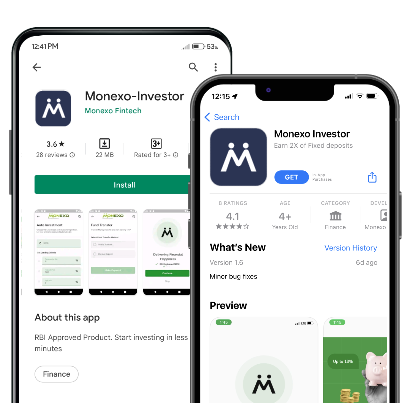What is the Monexo Secondary market ?
Monexo’s unique secondary market feature is a ‘first for Peer to Peer lending in India which allows lenders to sell their loan holdings to new buyers who are also lenders on the platform. Each of those holdings can be sold at a price decided by the seller which could be at par, premium or discount.
For the seller, the secondary market provides an option to assign some / all of the loans invested in to other lenders who may be willing to buy out the loan contract(s).
In this process, the seller gets a real opportunity for early exit of his performing P2P portfolio and gain additional liquidity. The proceeds from the secondary sale can be withdrawn by the lender or even better be used to invest in fresh loans listed in our regular, primary marketplace.
For the buyer, the secondary marketplace offers an excellent opportunity for additional portfolio diversification by allowing the opportunity to participate in loans which already have a sound payment trackrecord.
Monexo’s beta version of the secondary marketplace can now be accessed by existing and new lenders on www.monexo.co.
In the beta version, selling has been restricted to lenders with portfolio size (outstanding principal + Escrow balance) of Rs 5 lakhs and above. A buyer can be any existing or new lender with available Escrow balance to invest. But while deciding the price, looking into factors like risk premium, opportunity premium and yield for both parties is noteworthy.
Dynamics of the Secondary Market :
In a given scenario the probability of receiving the next EMI payment increases with every EMI payment that the borrower has made previously. Thus, if the lender has been receiving regular repayments he can charge a price slightly higher than the par value. That is to say he can charge a ‘risk premium’ now that the reliability of the borrower is higher than what it was in the beginning of the contract.
External factors can also affect the pricing of your loan.
If there has been a downward trend in the FD rates, the lender owns a loan holding that has an increasing value in comparison. This is again a time when he can charge a slight premium to the buyer to sell a paper that will give a higher return than what the external market is giving.
Here are a few illustrations of secondary market transactions:
Example 1: At par
Sellers view
| Initial Investment | Total amount of EMIs received |
Accrued Interest | Outstanding principal | Sale price at par | Earnings from sale at par |
| 15000 | 6562.68 | 78.43 | 10864.81 | 10943.24 | |
| Yield to sale | 20.52% | ||||
Buyers View
| Total amount of EMIs receivable | Accrued Interest | Outstanding principal | Purchase price at par |
| 13125.36 | 78.43 | 10864.81 | 10943.24 |
| Yield to maturity | 20.47% | ||
In a basic sale at par, the sale price will be equal to the outstanding principal balance and any accrued interest. This would give a similar yield to both parties. But besides the par value, you can also choose to sell it at a premium or a discount.
Now, how decide at what premium or discount price to sell your loan?
Example 2: Premiums
You have been holding a loan since the past 12 months whose borrower has been making regular payments, this is one of the times you can charge a risk premium on your holding. A premium for having held the loan during its most uncertain initial period.
For instance,
Sellers view
| Initial Investment | Total amount of EMIs received | Accrued Interest | Outstanding principal | Sale price at 5% premium | Sale price at 15% premium | Earnings at 5% premium | Earnings at 15% premium |
| 15000 | 6562.68 | 78.43 | 10864.81 | 11490.40 | 12584.73 | 3053.08 | 4147.41 |
| Yield to sale | 24.94% | 33.75% | |||||
Buyers View
| Total amount of EMIs Receivable | Accrued Interest | Outstanding principal | Purchase price at 5% premium | Purchase price at 15% premium |
| 13125.36 | 78.43 | 10864.81 | 11490.40 | 12584.73 |
| Yield to maturity | 14.46% | 4.29% | ||
In the above scenario, the seller had funded Rs.15000 of a loan and few months into the agreement he wishes to sell his holding off. Seeing that the borrower has proven his creditworthiness, the seller can then opt for charging a premium on his sale. This premium percentage should be decided keeping in mind the Yield to maturity of both the buyer and the seller.
Charging a 5% premium gives an agreeable yield of 24.94% and 14.46% to both the buyer and the seller.
But charging a 15% premium in the same scenario may give a lucrative yield of 33.75% to the seller but will give only a meager yield of 4.29% to the buyer.
Example 3: Discounts
Want to get out of your funding a little faster? You can then price your holdings at a discount.
At the same time buyers can grab the opportunity of getting phenomenal deals.
Sellers view
| Initial Investment | Total amount of EMIs received | Accrued Interest | Outstanding principal | Sale price at 5% discount | Earnings at 5% discount |
| 15000 | 6562.68 | 78.43 | 10864.81 | 10,396.08 | 1958.76 |
| Yield to sale | 16.07% | ||||
Buyers View
| Total amount of EMIs receivable | Accrued Interest | Outstanding principal | Purchase price at 5% discount |
| 13125.36 | 78.43 | 10864.81 | 10,396.08 |
| Yield to maturity | 27.25% | ||
In this case, by pricing the holding at a 5% discount the seller makes a very high paying offer. Thus, increasing his prospects of sale while yet maintaining a good return of 16.07%. Buyers will be keen to purchase this holding as it gives them a potential yield of 27.25%.
So keep in mind, charge a percent too low and you won’t get a good return. On the other hand charging a percent too high would hamper the sale prospects! Using the simulator provided on the website you can check the yields both the parties would get in different cases and then price your loan holding accordingly.
How can investors participate in Monexo’s secondary market :
To participate in Monexo’s secondary market, you need to either be an existing lender or sign up as a new lender on our platform. To sign up for a Monexo lending account, kindly visit www.monexo.co/in/lenders, create your lender account within minutes and transfer a minimum of Rs 1 lakh to our IDBI Trustee Escrow account.
An investment of Rs 5 lakhs or more will make you instantly eligible for both selling and buying in the beta version of our secondary market.
As always, you can also continue to invest in new loans originated by us through our primary marketplace and in parallel participate in the secondary market.
With the secondary market launch, Monexo further cements it’s leadership in the industry as a transparent, innovative and rewarding Peer to Peer lending marketplace for investors to participate in.




